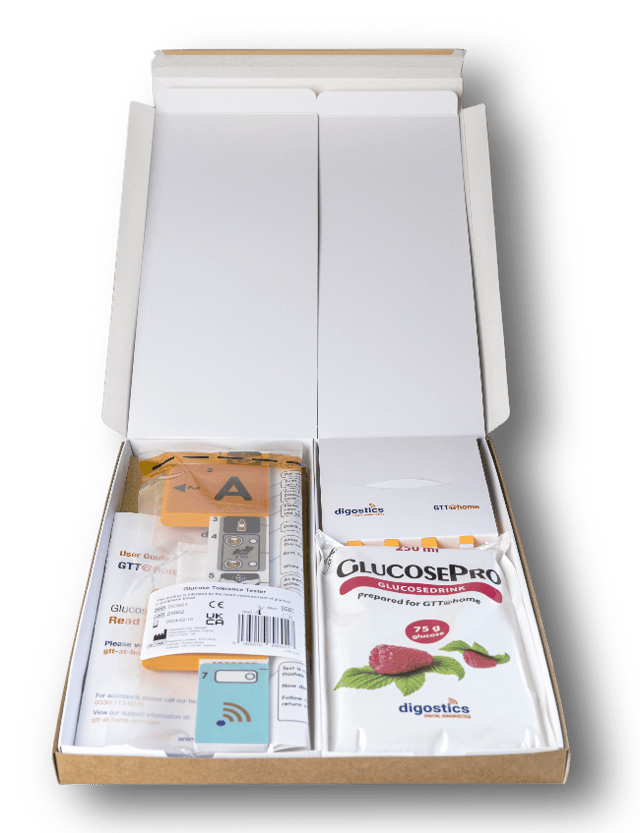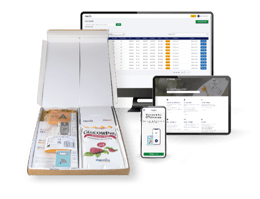For World Diabetes Day 2025, the International Diabetes Federation is focusing on the theme...
.png?height=200&name=World%20Diabetes%20Day%20(1).png)


Detecting Early-Stage Type 1 Diabetes
As part of ground-breaking pilots in type 1 diabetes screening, GTT@home offers a convenient new way to complete oral glucose tolerance tests (OGTT) at home.
This easy-to-use home test kit allows patients to perform the test on their own schedule, without the need for clinic visits, making the diagnostic process simpler and more flexible.
By enabling at-home testing, GTT@home has the ability to support healthcare teams in identifying type 1 diabetes sooner while giving patients greater control and flexibility during the diagnostic process.

Detecting Early-Stage Type 1 Diabetes (T1D)
GTT@home from Digostics is being piloted to be used for people being assessed for type 1 diabetes, offering a convenient new way to complete oral glucose tolerance tests (OGTT) at home.
This easy-to-use home test kit allows patients to perform the test on their own schedule, without the need for clinic visits, making the diagnostic process simpler and more flexible.
By enabling at-home testing, GTT@home has the ability to support healthcare teams in identifying type 1 diabetes sooner while giving patients greater control and flexibility during the diagnostic process.
50% of newly diagnosed have life-threatening diabetic ketoacidosis.
Removing Barriers, Improving Outcomes
Screening pathways for T1D are advancing rapidly, with population-based programmes now under development and, in some countries, moving toward implementation. Ensuring timely access to oral glucose tolerance testing is a critical component of these pathways - but conventional in-clinic delivery creates challenges for both patients and providers.
For children and families in particular, uptake of traditional in-clinic OGTT can be low. By removing logistical barriers, GTT@home can make repeat annual testing more accessible and acceptable, supporting earlier identification of disease progression.
For healthcare teams, at-home testing can streamline workflows by reducing administrative and resource burdens. This allows more time to be dedicated to interpretation, counselling, and patient support, while ensuring consistent, high-quality data from the diagnostic process.
With GTT@home, OGTT can integrate seamlessly into T1D screening programmes - improving efficiency, increasing uptake, and enhancing the patient experience.


Removing Barriers, Improving Outcomes
Screening pathways for T1D are advancing rapidly, with population-based programmes now under development and, in some countries, moving toward implementation. Ensuring timely access to oral glucose tolerance testing is a critical component of these pathways - but conventional in-clinic delivery creates challenges for both patients and providers.
For children and families in particular, uptake of traditional in-clinic OGTT can be low. By removing logistical barriers, GTT@home can make repeat annual testing more accessible and acceptable, supporting earlier identification of disease progression.
For healthcare teams, at-home testing can streamline workflows by reducing administrative and resource burdens. This allows more time to be dedicated to interpretation, counselling, and patient support, while ensuring consistent, high-quality data from the diagnostic process.
With GTT@home, OGTT can integrate seamlessly into T1D screening programmes - improving efficiency, increasing uptake, and enhancing the patient experience.
"With the ability to have those at risk use a product that is simple, requires a fingerprick and not a venous draw, and can be done within the person’s own home, I have no doubt that GTT@ home will be of great value to both patients and providers."
Professor Jennifer Sherr
Yale University School of Medicine

"With the ability to have those at risk use a product that is simple, requires a fingerprick and not a venous draw, and can be done within the person’s own home, I have no doubt that GTT@ home will be of great value to both patients and providers."
Professor Jennifer Sherr
Yale University School of Medicine
Once a test is arranged through the Digostics booking and review portal, a GTT@home kit is promptly dispatched to the patient. They can then watch the accompanying online video for guidance and use the clear step-by-step instructions included in the kit to carry out their OGTT with confidence.
And that’s really all it takes!
Our friendly Customer Care team is on hand seven days a week to offer support whenever it’s needed. We also keep track of upcoming or overdue tests to ensure patients stay on schedule. As soon as results are processed, you’ll receive a notification to log back into the Digostics portal and complete your clinical review.
We’re making type 1 diabetes testing simpler, faster, and more accessible for everyone.
Once a test is arranged through the Digostics booking and review portal, a GTT@home kit is promptly dispatched to the patient. They can then watch the accompanying online video for guidance and use the clear step-by-step instructions included in the kit to carry out their OGTT with confidence.
And that’s really all it takes!
Our friendly Customer Care team is on hand seven days a week to offer support whenever it’s needed. We also keep track of upcoming or overdue tests to ensure patients stay on schedule. As soon as results are processed, you’ll receive a notification to log back into the Digostics portal and complete your clinical review.
We’re making type 1 diabetes testing simpler, faster, and more accessible for everyone.
Click the button below for more GTT@home product-specific information exploring:
• the GTT@home test kit's contents
• the novel GTT@home test device
• at-home versus in-clinic test comparisons
• patient and healthcare professional support




Click the button below for more GTT@home product-specific information exploring:


The EDENT1FI consortium is a global collaboration between 27 partners in 13 countries from academia, industry and patient organizations, bringing their knowledge and expertise together, with one common goal: to arrest type 1 diabetes at the pre-clinical phase. EDENT1FI is developing a T1D screening programme for application across Europe, and is assisting with the development and implementation of therapeutics to delay and perhaps even prevent T1D.
Click below to read the press release.


The EDENT1FI consortium is a global collaboration between 27 partners in 13 countries from academia, industry and patient organizations, bringing their knowledge and expertise together, with one common goal: to arrest type 1 diabetes at the pre-clinical phase. EDENT1FI is developing a T1D screening programme for application across Europe, and is assisting with the development and implementation of therapeutics to delay and perhaps even prevent T1D.
Click below to read the press release.
"Our collaborative efforts are driven by a shared commitment to making a tangible impact in the lives of those affected by Type 1 Diabetes. Together, we aim to pioneer innovative approaches that will redefine the landscape of T1D diagnosis and care."
Prof. Chantal Mathieu
Coordinator of EDENT1FI
GTT@home has been evaluated in a major UK study led by researchers at the National Institute for Health and Care Research (NIHR) Oxford Biomedical Research Centre. T1D Early is developing a T1D screening programme for pre-school children in the UK. The study has now completed, and the results are being analysed ahead of publication.
Click below to read the press release.


GTT@home has been evaluated in a major UK study led by researchers at the National Institute for Health and Care Research (NIHR) Oxford Biomedical Research Centre. T1D Early is developing a T1D screening programme for pre-school children in the UK. The study has now completed, and the results are being analysed ahead of publication.
Click below to read the press release.
"Early diagnosis of T1D relies on OGTTs, but we know these tests are not well tolerated, especially by very young children. At-home testing could be a major breakthrough for reducing the burden of testing. We look forward to seeing the results of our study to help us understand how GTT@home might be used in routine care."
Dr Rabbi Swaby
Nuffield Department of Medicine

Researchers at Yale School of Medicine, funded by Breakthrough T1D, are evaluating GTT@home to monitor early-stage T1D in individuals with T1D autoantibodies. The study aims to assess the accuracy, usability, and acceptance of GTT@home, potentially paving the way for wider use in early T1D detection and monitoring across the USA.
Click below to read the press release.

Researchers at Yale School of Medicine, funded by Breakthrough T1D, are evaluating GTT@home to monitor early-stage T1D in individuals with T1D autoantibodies. The study aims to assess the accuracy, usability, and acceptance of GTT@home, potentially paving the way for wider use in early T1D detection and monitoring across the USA.
Click below to read the press release.
"Traditional in-clinic OGTTs are time-consuming, can be challenging to navigate for younger individuals, and require significant clinic resources. As new therapies emerge that can delay and, hopefully, one day prevent the progression of type 1 diabetes, it is critical to have the tools to accurately and reliably monitor and diagnose the early stages of the disease. A validated at-home testing approach would represent a major breakthrough."
Dr. Raquel Lopez-Diez
Yale University School of Medicine
Digostics is proud to offer GTT@home - the most accessible and scalable way for healthcare professionals to achieve their T1D testing objectives.
Register to download the GTT@home for T1D datasheet.

Check out the latest posts from Insights, the Digostics blog.